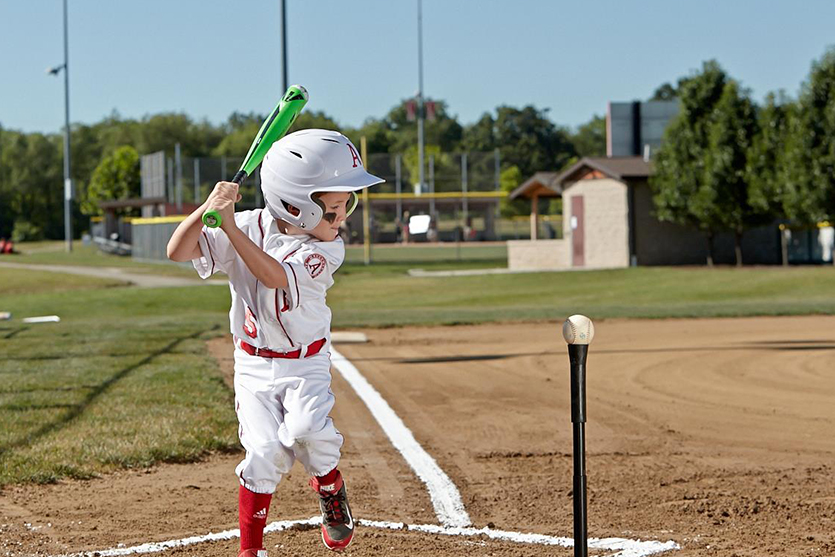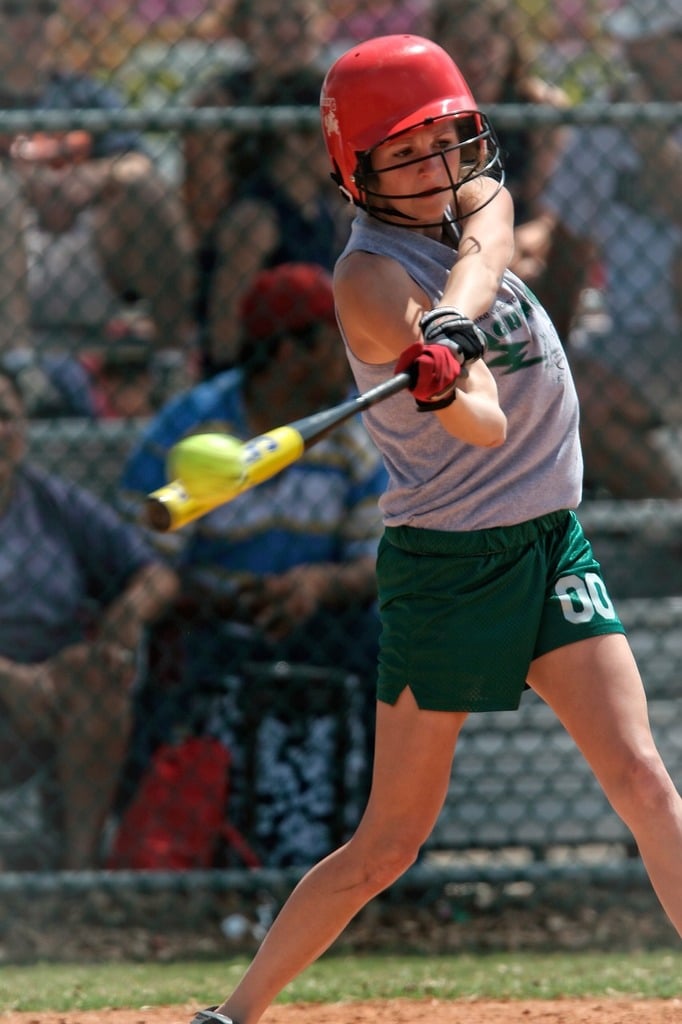Key Points
For a strong swing, a balanced stance is essential.
Good hand position and grip improve bat control.
Lower body mechanics are crucial for generating explosive power.
Basic drills can significantly enhance hitting technique.
Regular practice and tracking progress are key to development.
Creating a Powerful Swing
In youth baseball and softball, hitting the ball with power isn’t just about brute strength. It’s about technique, timing, and the correct mechanics. To help young players unleash their potential at the plate, we need to focus on building a strong foundation that they can build upon. This is where understanding and practicing the correct hitting techniques come in.
The Importance of Technique Over Strength in Young Athletes

“Teach Your Child to Swing a Baseball Bat” from www.dickssportinggoods.com and used with no modifications.
Young athletes often believe that raw strength is the key to a powerful swing. However, the real key is technique. A good swing utilizes the entire body, not just the arms, to drive the ball. By concentrating on technique, young hitters can maximize their natural strength and enhance their batting performance.
Key Elements of Youngster Batting Techniques
Let’s explore the key elements of youngster batting techniques. These are the foundation for a good hit. We’ll examine how to establish a correct position, the significance of hand placement and grip, and how to involve the lower body for that explosive power every batter wants.
Position and Stability: Preparing for Triumph
Let’s start from the beginning: a strong position is the foundation of a mighty swing. Here’s what you should keep in mind:
Stand with your feet shoulder-width apart: This will give you a solid base and help distribute your weight evenly.
Keep your knees slightly bent: This will help you maintain balance and prepare to swing.
Rest your weight on the balls of your feet: This is crucial for fast movements and a powerful swing.
Keep in mind, a balanced stance isn’t just about standing correctly; it’s about being prepared to move.
How to Hold the Bat: Mastering the Grip
Your grip on the bat can greatly affect your swing. Here are some important things to remember:
Align your knuckles: This allows for a strong grip while maintaining flexibility.
Keep your hands near your body: Keeping your hands near your body during the swing allows for maximum bat speed and control.
Loose grip: A tight grip on the bat can slow your swing. Keep it tight but loose.
With the correct grip, hitters can control the bat accurately and hit the ball with more power.
How the Legs Contribute to Power
The legs are the base of a strong swing. They kick off the kinetic chain that eventually results in bat speed and ball distance. To tap into this power, young hitters need to understand how to use their legs from the beginning of the swing. Here’s how:
Firstly, athletes should begin with a minor bend in their knees, which creates a spring-like effect during the swing. This bend also assists in maintaining equilibrium and stability. As the pitch approaches, the batter should push their back leg towards the ball, utilizing the ground as leverage to create force that travels up through the body, to the hips, and finally to the bat.
Maximizing Hip Rotation for Optimal Power
Hip rotation is a vital part of the hitting process as it connects the power created by the legs to the bat’s swing. To maximize hip rotation, players should envision turning their back pocket towards the pitcher when beginning their swing. This movement will create a whip-like effect with the bat, increasing power.
It’s crucial to avoid excessively rotating the hips, as this can result in pulling off the ball and decreasing the swing’s effectiveness. The objective is a controlled, strong turn that keeps the hitter’s head motionless and eyes focused on the ball.
Training Exercises for Young Athletes

Exercises are crucial for young batters to rehearse and refine their style. Let’s discuss a few exercises that concentrate on various parts of the batting process:
Keep in mind that repetition is crucial for these exercises. Young batters should strive to perform these youth baseball drills on a regular basis, concentrating on the quality of each swing rather than the number of swings.
Positive reinforcement and praise from coaches and parents can keep young players engaged and make their practice sessions more enjoyable.
Drill 1: Tee Work for Accurate Hitting
Using a batting tee can assist hitters in hitting the ball with the right part of the bat. The tee should be adjusted to waist height, and the hitter should aim to drive the ball straight up the field. This drill stresses the importance of a level swing and aids in the development of muscle memory for the correct hand path to the ball.
Exercise 2: Gentle Throws for Rhythm and Force
Gentle throws is an exercise where a trainer or buddy softly throws balls to the batter from the side. The main point here is to time the swing to connect with the ball as it crosses the plate. This exercise also lets batters practice creating force from their legs and hips, as they have to synchronize their lower body motion with the incoming throw.
Drill 3: Front Toss for Visual Tracking and Reaction
Front toss is like soft toss, but the balls are tossed from in front of the hitter. This drill enhances a hitter’s capacity to track the ball from the pitcher’s hand and react swiftly. It’s a great way to mimic game-like situations and helps hitters adapt to different speeds and locations.
When performing front toss, it’s important for the batter to keep a steady posture and concentrate on using their legs and hips to power through the ball. This drill can also be adjusted to help practice hitting slower pitches or pitches from different areas of the strike zone.
Boost Your Batting with Advanced Techniques
After young hitters have a good handle on the fundamentals, they can start incorporating more advanced techniques to up their batting power. These techniques can help transform a decent hitter into a power hitter.
Advanced methods require a blend of mental and physical changes that enable batters to more effectively predict pitches and take full advantage of their body mechanics.
Hitting the Ball Further with Proper Follow-Through
Proper follow-through after hitting the ball means continuing the swing. After making contact with the ball, players should extend their arms fully and rotate their hips completely. This allows the power generated from the legs and hips to be transferred to the ball, often resulting in hits that travel a greater distance.
Grasping the Concept of Load and Separation for Timing
The terms ‘load’ and ‘separation’ describe the preparatory movements a hitter makes before swinging. ‘Loading’ refers to shifting their weight onto the back leg, and ‘separation’ refers to creating distance between their hands and body. This helps to generate more power when they swing. A good analogy is pulling back on a slingshot before releasing it.
It’s crucial to get the timing of the load and separation just right. If it’s done too early or too late, it can disrupt the whole swing. Hitters should collaborate with coaches to determine the timing that suits them best.
Take, for instance, a young player named Alex who had trouble hitting the ball beyond the infield. After focusing on loading correctly and creating separation, Alex began to hit the ball with more force, sending line drives into the outfield gaps. This adjustment didn’t just happen overnight; it required practice and patience, but the results were noticeable.
Now that you have these techniques and drills at your disposal, you’re well-prepared to help young hitters improve their skills. Above all, always stress the importance of practice, patience, and persistence. Hitting is a complex skill that takes time to perfect, but with the right guidance, any young player can increase their power at the plate.
Now, let’s change our focus and answer some common questions that can help create future champions in the world of youth baseball and softball.
FAQ: Nurturing Tomorrow’s Winners
If you’re a coach or parent, you probably have a ton of questions about how to best help your young athletes become strong hitters. Here are some responses to frequently asked questions that can help you steer them in the right direction.
How Frequently Should Young Athletes Train in Batting?
Steadiness is the secret to mastering any craft, particularly one as intricate as batting in baseball or softball. However, it’s not just the quantity of training that matters—it’s the standard of it as well.
Youth players should strive to have organized hitting practice a minimum of 2-3 times a week. This gives them the opportunity to refine their mechanics and develop muscle memory, while avoiding the risk of burnout or injuries from overuse.
It’s not about how much you practice, but how you practice: Make sure every swing has a purpose, rather than just swinging for the sake of it.
Give it a rest: Young muscles need time to recover, so don’t overdo it with back-to-back practices.
Practice like you play: Incorporate game-like situations into practice to build adaptability.
Keep in mind, every player is unique, so adjust the practice schedule to their individual needs and energy levels.

Is There an Age Limit to Start Learning Advanced Techniques?
Definitely not! There’s no such thing as being too young or too old to start learning advanced hitting techniques. The important thing is to make sure that the player has a firm understanding of the basics before moving on to more complicated skills.
Young athletes can start with basic versions of complex techniques and progressively enhance them as they mature and improve. This step-by-step method helps avoid discouragement and ensures that athletes don’t form poor habits.
What Are the Most Frequent Errors in Youth Hitting Techniques?
Errors are a normal part of learning, but identifying and fixing them sooner can lead to major progress. Here are some typical mistakes:
For example, over-swinging is a common problem. Many young players believe that hitting the ball as hard as they can will make it go further. But this usually results in poor timing and less control over the bat. Another common error is not distributing their weight correctly, which can affect their balance and their ability to generate power.
Coaches need to give clear feedback and correct these errors through specific drills and practice.
How Can You Keep Young Players Interested During Practice?
Keeping practice interesting is key to keeping the attention and enthusiasm of young players. For example, incorporating youth baseball drills can make practice more dynamic and fun.
For instance, you can initiate mini contests during training sessions, like finding out who can hit the maximum line drives or who can hit the ball to various fields. This not only makes training enjoyable but also aids in developing situational hitting abilities.
Moreover, change the drills and challenges to maintain the training session lively and thrilling. Including game-like situations can also assist players in understanding the direct application of their abilities.
When Is the Right Time for Players to Begin Concentrating on Hitting Power?
Once players have a solid grasp on the fundamental mechanics of hitting, they can begin to concentrate on hitting power. This usually occurs around the ages of 13 or 14, when players have gained sufficient physical strength and coordination.
Prior to this, the focus should be on mastering the correct technique, hand-eye coordination, and grasping the basics of the sport. Specializing too soon may result in a player who is only good at one thing, so it’s critical to first establish a diverse range of abilities.
In conclusion, remember that every batter is different, and there’s no universal method to increase batting power. The path to becoming a skilled batter is paved with trials, adjustments, and development. But with commitment, the right guidance, and consistent practice, young athletes can greatly enhance their batting technique and power. Encourage them to keep swinging, keep learning, and keep enjoying the game.
Leave a Reply